初中英语语法:一般现在时
初中英语语法知识之一般现在时
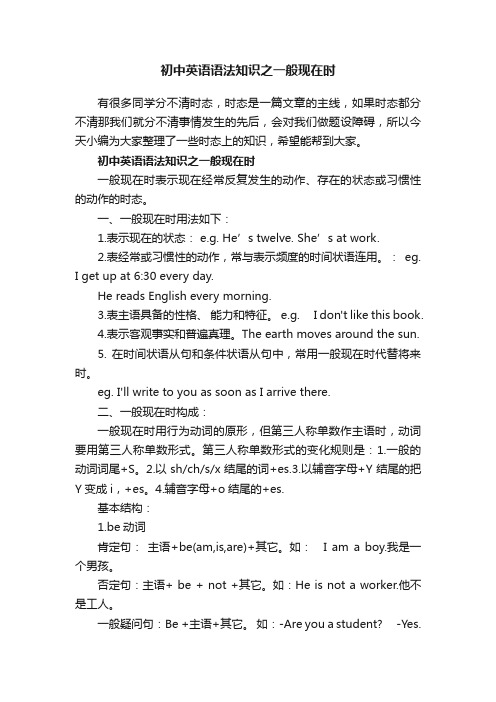
初中英语语法知识之一般现在时有很多同学分不清时态,时态是一篇文章的主线,如果时态都分不清那我们就分不清事情发生的先后,会对我们做题设障碍,所以今天小编为大家整理了一些时态上的知识,希望能帮到大家。
初中英语语法知识之一般现在时一般现在时表示现在经常反复发生的动作、存在的状态或习惯性的动作的时态。
一、一般现在时用法如下:1.表示现在的状态:e.g. He’s twelve. She’s at work.2.表经常或习惯性的动作,常与表示频度的时间状语连用。
:eg.I get up at 6:30 every day.He reads English every morning.3.表主语具备的性格、能力和特征。
e.g. I don't like this book.4.表示客观事实和普遍真理。
The earth moves around the sun.5. 在时间状语从句和条件状语从句中,常用一般现在时代替将来时。
eg. I'll write to you as soon as I arrive there.二、一般现在时构成:一般现在时用行为动词的原形,但第三人称单数作主语时,动词要用第三人称单数形式。
第三人称单数形式的变化规则是:1.一般的动词词尾+S。
2.以sh/ch/s/x结尾的词+es.3.以辅音字母+Y结尾的把Y变成i,+es。
4.辅音字母+o结尾的+es.基本结构:1.be动词肯定句:主语+be(am,is,are)+其它。
如:I am a boy.我是一个男孩。
否定句:主语+ be + not +其它。
如:He is not a worker.他不是工人。
一般疑问句:Be +主语+其它。
如:-Are you a student? -Yes.I am. / No, I'm not.特殊疑问句:疑问词+一般疑问句。
如:Where is my bike?2.行为动词1) 当主语为第一,二人称及复数时,助动词为do肯定句:主语+动词原形(+其它)。
初中一般现在时【讲解+练习】

一般现在时的用法一、概述一般现在时表示习惯性、经常性、反复性的动作或存有的状态。
“习惯性、经常性、反复性”是一般现在时的三大特性,它不表示特定时间内发生的事。
二、一般现在时的结构时态的结构指的是动词的变化形式。
一般现在时间有两种结构,一种是动词原形,用于主语为非第三人称时的情况;另一种为动词的第三人称单数形式,用于主语为第三人称时的情况。
Eg1.We often get up early in the morning.Eg2.My father often gets up early in the morning.三、谈谈“主语为三单,其后动词s添”在一般现在时中,当主语为第三人称单数时,谓语动词要用第三人称单数形式。
能够简单叙述为“主语为三单,其后动词s添”。
何谓第三人称单数?用一句话概括就是“非你、非我、非复数”,如he, she, it, my father, my mother, my sister, our English teacher, Tom, Mike, Liu Jia, China, my book, etc.Eg3.He sometimes goes to school by bike.Eg4.My father works in the hospital as a doctor.四、动词第三人称单数变化规则动词第三人称变化的规则与可数名词复数变化的规则相同。
规则一、一般在词尾加-s。
如:looks, puts. reads, sees, skis等。
规则二、以-o, -s, -x, -sh, -ch结尾的加-es。
如:goes, does, misses, passes, mixes, fixes, pushes, wishes, watches, teaches,等。
规则三、以辅音字母加y结尾的,变y为i,再加-es。
注意一定是辅音字母加y才变,若是元音字母加y,则直接加-s。
初中英语语法——一般现在时知识点总结归纳资料讲解
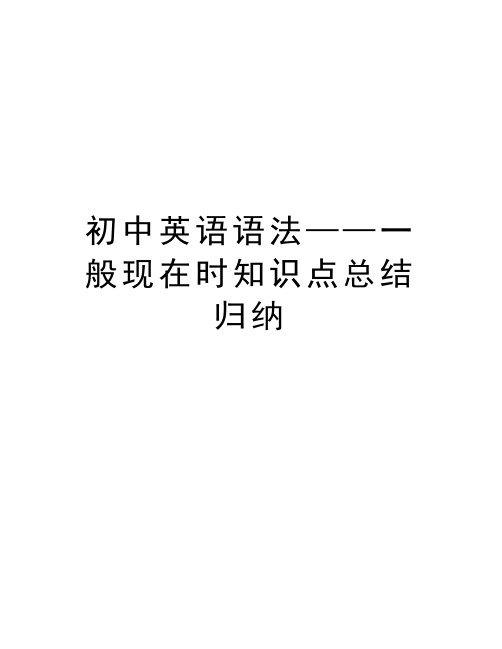
初中英语语法——一般现在时知识点总结归纳初中英语语法——一般现在时知识点总结归纳一般现在时——表示一般性,经常性的动作或一般性事实。
概念:表示经常发生的动作或经常存在的状态。
常和 always , often , usually , sometimes , every day 等表时间的状语连用。
如:1) I go to school every day . 我每天都去学校。
(表经常)2) He is always like that . 他总是那样。
(表状态)构成:1) 主语 + be (am / are / is ) +……2) 主语 + 实义动词/三单动词+ …【解析】1、含有be动词的句子He is a teacher.The girl is very beautiful.Tim and Jack are students.★变疑问句将be动词移到句首Is he a teacher?Is the girl very beautiful?Are Tim and Jack students?★变否定句在be动词后面加notHe is not a teacher.The girl is not very beautiful.Tim and Jack are not students.★肯定回答及否定回答Yes, he is. / No, he is not.Yes, she is. / No, she is not.Yes, they are. / No, they are not.2、不含有be动词的句子,即含有一般动词的句子。
(1)第三人称单数及单数名词He likes books.She likes him.The dog likes bones.★变疑问句在句首加does, 动词变为原型Does he like books?Does she like him?Does the dog like bones?★变否定句在主语及动词之间加doesn't, 动词变为原型,原句中的动词不再有第三人称变化。
一般现在时的知识点归纳七年级

一般现在时的知识点归纳七年级七年级英语教学中,一般现在时是最重要的语法点之一。
通过良好的教学方法和个性化的教学方式,学生们可以轻松掌握这一知识点。
在本文中,我们将对一般现在时进行深入剖析,来帮助学生更好地掌握这一知识点。
一、一般现在时的定义一般现在时指的是现在正在发生或经常发生的动作或状态。
它的时态形式为:主语(第三人称单数要加s或es) + 动词原形。
例如:He plays basketball.(他打篮球。
)二、一般现在时的用法1. 表述客观事实:比如地理事实、自然现象、名人事实等。
例如:The sun rises in the east.(太阳从东方升起。
)2.表述经常性动作或状态:比如习惯性的动作、日常行为、反复发生的动作等。
例如:I usually go to bed at 10 p.m.(我通常在晚上10点钟睡觉。
)3.表述真理或普遍事实:比如科学定理、社会现象、人定律等。
例如:Water freezes at 0 degrees Celsius.(水在零度时结冰。
)4. 表示主语所具备的特征等性质。
例如:She is kind and friendly.(她友善又和蔼。
)三、一般现在时的标志词一般现在时没有专门的标志词,但在使用中,我们通常可以根据上下文来判断。
四、一般现在时的否定句和疑问句1.否定句:在be动词后加not,其他动词在前面加助动词do/does,其后紧随not。
例如:He does not run fast.(他跑得不快。
)2. 疑问句:将助动词do/does提前到主语前,其他句子成分不变。
例如: Do you like playing basketball?(你喜欢打篮球吗?)五、常见的时间状语时间状语指的是句子中表示时间的词或短语。
以下是常见的时间状语:1. every day (每天)2. every week (每周)3. every month (每月)4. every year (每年)5. on Monday (在星期一)6. in the morning (在早晨)7. at night (在晚上)8. at the weekend (在周末)六、一般现在时常见错误1. 第三人称单数动词形式错误:在第三人称单数主语后要加s/es。
初中英语语法——一般现在时讲解

初中英语时态——一般现在时讲解一般现在时主要用法1.表示经常性、习惯性的动作或者状态标志性词:every、always、usually、often、sometimes、seldom、never I get up at 7 every day.我每天7点起床。
That girl usually walks to school.那个女孩通常步行上学。
2.表示科学真理、有规律的自然现象Light travels faster than sound.光速比声速快。
The sun rises in the east.太阳从东方升起。
3.表示目前的状态、喜好等I am a student.我是一名学生。
My father likes reading books.我父亲喜欢读书。
4.if条件状语从句和when时间状语从句:主将从现He will go to the park if it is sunny tomorrow.如果明天天气晴朗,他将去公园。
区别:I wonder if it will be sunny tomorrow.我想知道明天天气是否晴朗。
一般现在时句型结构1.谓语是be动词(am/is/are)①肯定句:主语+be动词+其他.I am fifteen years old.You are a clever boy.She is an English teacher.②否定句:主语+be动词+not+其他.I am not fifteen years old.You are not a clever boy.She is not an English teacher.③一般疑问句:Be动词+主语+其他?肯定回答:Yes,主语+be动词.否定回答:No, 主语+ be动词+not.—Are you fifteen years old?—Yes,I am./No,I'm not.—Is she an English teacher?—Yes, she is./No, she isn't.④特殊疑问句:特殊疑问词+be动词+主语+其他? Where are they?2.谓语动词是实义动词主语是第一人称、第二人称、第三人称复数:①肯定句:主语+动词原形+其他.I have a lot of interesting books.You look nice in the dress.They go shopping every weekend.②否定句:主语+don't+动词原形+其他.I don't have a lot of interesting books.You don't look nice in the dress.They don't go shopping every weekend.③一般疑问句:Do+主语+动词原形?肯定回答:Yes,主语+do.否定回答:No, 主语+ don't.—Do you have a lot of interesting books?—Yes, I do./ No, I don't.④特殊疑问句:特殊疑问词+do+主语+动词原形+其他? When do you go to school?What do they like?主语是第三人称单数:①肯定句:主语+动词第三人称单数+其他.He has a short black hair.Helen likes juice.②否定句:主语+doesn't+动词原形+其他.He doesn't have short black hair.Helen doesn't like juice.③一般疑问句:Does+主语+动词原形+其他?肯定回答:Yes,主语+does.否定回答:No, 主语+doesn't.—Does he have short black hair?—Yes, he does./No, he doesn't.④特殊疑问句:特殊疑问词+does+主语+动词原形+其他? Which subject does your sister like best?Where does he often go after school?3. 谓语是情态动词①肯定句:主语+情态动词+动词原形+其他.I can draw beautiful pictures.He can speak English well.They can borrow some magazines from the library.②否定句:主语+情态动词+not+动词原形+其他.I can't draw beautiful pictures.He can't speak English well.They can't borrow some magazines from the library.③一般疑问句:情态动词Can+主语+动词原形?肯定回答:Yes,主语+情态动词.否定回答:No, 主语+ 情态动词+not.—Can you play volleyball?—Yes,I can./No, I can't.④特殊疑问句:特殊疑问词+情态动词+主语+动词原形+其他?回答:主语+情态动词+动词原形+其他.—What can you do?—I can play the piano.第三人称单数一、人称代词he, she, it是第三人称单数。
初中英语语法——一般现在时知识点总结归纳
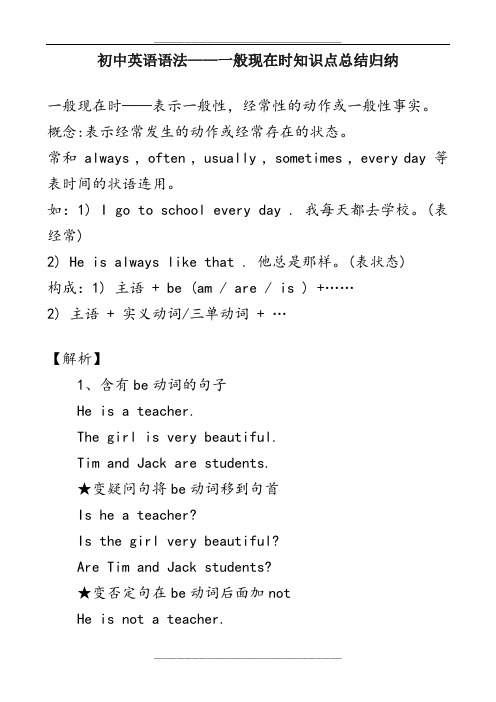
初中英语语法——一般现在时知识点总结归纳一般现在时——表示一般性,经常性的动作或一般性事实。
概念:表示经常发生的动作或经常存在的状态。
常和 always , often , usually , sometimes , every day 等表时间的状语连用。
如:1) I go to school every day . 我每天都去学校。
(表经常)2) He is always like that . 他总是那样。
(表状态)构成:1) 主语+ be (am / are / is ) +……2) 主语 + 实义动词/三单动词+ …【解析】1、含有be动词的句子He is a teacher.The girl is very beautiful.Tim and Jack are students.★变疑问句将be动词移到句首Is he a teacher?Is the girl very beautiful?Are Tim and Jack students?★变否定句在be动词后面加notHe is not a teacher.The girl is not very beautiful.Tim and Jack are not students.★肯定回答及否定回答Yes, he is. / No, he is not.Yes, she is. / No, she is not.Yes, they are. / No, they are not.2、不含有be动词的句子,即含有一般动词的句子。
(1)第三人称单数及单数名词He likes books.She likes him.The dog likes bones.★变疑问句在句首加does, 动词变为原型Does he like books?Does she like him?Does the dog like bones?★变否定句在主语及动词之间加doesn't, 动词变为原型,原句中的动词不再有第三人称变化。
(完整word版)人教版英语初一语法一般现在时
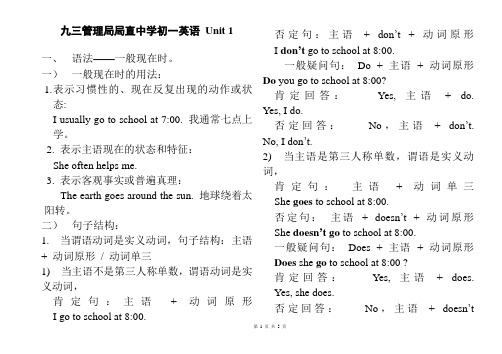
九三管理局局直中学初一英语Unit 1一、语法——一般现在时。
一)一般现在时的用法:1.表示习惯性的、现在反复出现的动作或状态:I usually go to school at 7:00. 我通常七点上学。
2. 表示主语现在的状态和特征:She often helps me.3. 表示客观事实或普遍真理:The earth goes around the sun. 地球绕着太阳转。
二)句子结构:1. 当谓语动词是实义动词,句子结构:主语+ 动词原形/ 动词单三1) 当主语不是第三人称单数,谓语动词是实义动词,肯定句:主语+ 动词原形I go to school at 8:00.否定句:主语+ don’t+ 动词原形I don’t go to school at 8:00.一般疑问句:Do + 主语+ 动词原形Do you go to school at 8:00?肯定回答:Yes, 主语+ do. Yes, I do.否定回答:No,主语+ don’t. No, I don’t.2) 当主语是第三人称单数,谓语是实义动词,肯定句:主语+ 动词单三She goes to school at 8:00.否定句:主语+ doesn’t + 动词原形She doesn’t go to school at 8:00.一般疑问句:Does + 主语+ 动词原形Does she go to school at 8:00 ?肯定回答:Yes, 主语+ does.Yes, she does.否定回答:No,主语+ doesn’tNo, she doesn’t.3)动词第三人称单数的变化规则:a. 一般情况下,在词尾加-s:play- plays get- gets.b. 以s,x,sh,ch结尾的动词,在词尾加-es:watch- watches go- goes.c. 以辅音字母加y结尾的动词,要把y变成i,再加-es:fly- flies study- studies2. 当谓语动词是be动词,句子结构:主语+ be 的适当形式1) 肯定句:主语+ be (am / is are)I am an English teacher.否定句:主语+ be (m / is are)+ notI am not an English teacher.一般疑问句:Be(Is/ Are) + 主语Are you an English teacher?肯定回答:Yes, 主语+ be(am/ is/ are). Yes, I am.否定回答:No,主语+ don’t. No, I am not.2)be动词的使用口诀:我用am,你用are,is连着他她塔,单数is 复数are。
初中英语知识点归纳一般现在时的构成与用法
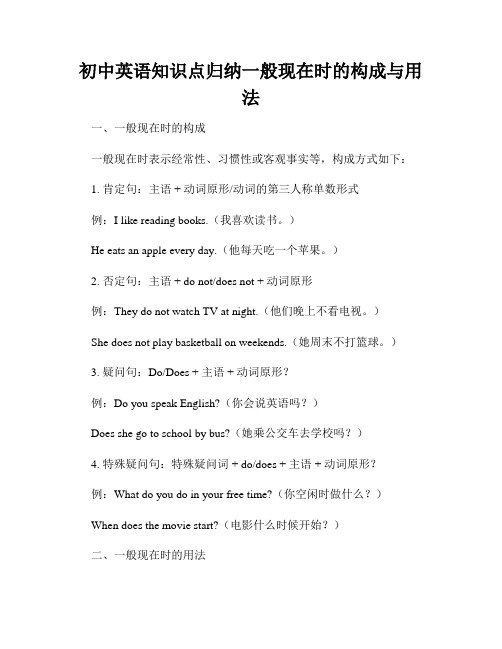
初中英语知识点归纳一般现在时的构成与用法一、一般现在时的构成一般现在时表示经常性、习惯性或客观事实等,构成方式如下:1. 肯定句:主语 + 动词原形/动词的第三人称单数形式例:I like reading books.(我喜欢读书。
)He eats an apple every day.(他每天吃一个苹果。
)2. 否定句:主语 + do not/does not + 动词原形例:They do not watch TV at night.(他们晚上不看电视。
)She does not play basketball on weekends.(她周末不打篮球。
)3. 疑问句:Do/Does + 主语 + 动词原形?例:Do you speak English?(你会说英语吗?)Does she go to school by bus?(她乘公交车去学校吗?)4. 特殊疑问句:特殊疑问词 + do/does + 主语 + 动词原形?例:What do you do in your free time?(你空闲时做什么?)When does the movie start?(电影什么时候开始?)二、一般现在时的用法一般现在时用于以下几种情况:1. 表示经常性或习惯性的动作或状态。
例:My mother often cooks dinner for us.(我妈妈经常给我们做晚饭。
)We usually go to the park on weekends.(我们通常在周末去公园。
)2. 表示客观事实、自然规律或科学真理。
例:The sun rises in the east.(太阳从东方升起。
)Water boils at 100 degrees Celsius.(水在100摄氏度沸腾。
)3. 表示现有状况或个人特征。
例:I have two cats.(我有两只猫。
)She lives in London.(她住在伦敦。
初中英语一般现在时知识点

初中英语一般现在时知识点一般现在时是指在现在发生或存在的动作、状态和习惯。
以下是一般现在时的知识点:1. 形式:一般现在时的形式为主语 + 动词原形(或第三人称单数形式)、主语 + be动词原形(am, is, are)+ 动词-ing形式。
2. 第三人称单数形式:当主语是第三人称单数(he, she, it)时,动词要加 -s或 -es。
例如:She likes to play the piano.3. be动词的使用:be动词表示临时状态、习惯性状态和现有派生动词的被动语态。
例如:I am a student. They are playing soccer. The book is being read.4. 动词的形式变化:有些动词在一般现在时态中有特殊的形式变化。
例如:go -> goes, do -> does, have -> has。
5. 可数名词和不可数名词:可数名词使用单数形式,不可数名词使用单数或不变形式。
例如:She has two cats. I have a lot of water.7. 表示真理、自然现象和客观事实:一般现在时也可以用来表示真理、自然现象和客观事实。
例如:The sun rises in the east. Water boils at 100 degrees Celsius.8. 表示未来时间:一般现在时有时也可以用来表示未来安排或时间表中的事件。
例如:The train leaves at 6 o'clock tomorrow.9. 否定句和疑问句:一般现在时的否定句结构为主语 + donot/does not + 动词原形。
疑问句结构为Do/Does + 主语 + 动词原形。
以上是一般现在时的主要知识点,通过学习和掌握这些知识点,你就能正确运用一般现在时来描述现在的动作、状态和习惯。
初中英语语法知识之一般现在时
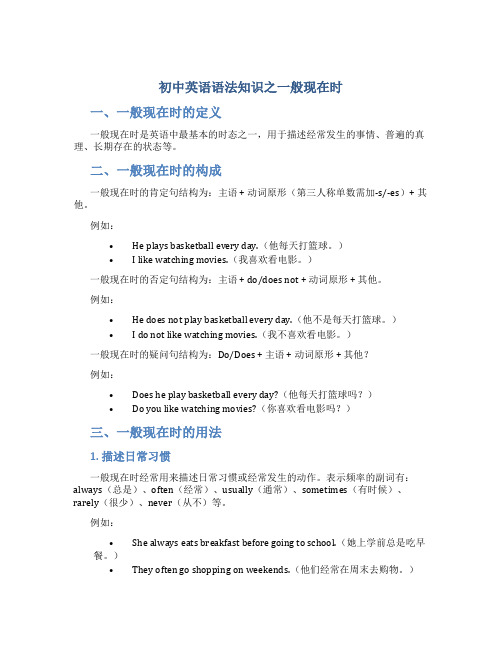
初中英语语法知识之一般现在时一、一般现在时的定义一般现在时是英语中最基本的时态之一,用于描述经常发生的事情、普遍的真理、长期存在的状态等。
二、一般现在时的构成一般现在时的肯定句结构为:主语 + 动词原形(第三人称单数需加-s/-es)+ 其他。
例如:•He plays basketball every day.(他每天打篮球。
)•I like watching movies.(我喜欢看电影。
)一般现在时的否定句结构为:主语 + do/does not + 动词原形 + 其他。
例如:•He does not play basketball every day.(他不是每天打篮球。
)•I do not like watching movies.(我不喜欢看电影。
)一般现在时的疑问句结构为:Do/Does + 主语 + 动词原形 + 其他?例如:•Does he play basketball every day?(他每天打篮球吗?)•Do you like watching movies?(你喜欢看电影吗?)三、一般现在时的用法1. 描述日常习惯一般现在时经常用来描述日常习惯或经常发生的动作。
表示频率的副词有:always(总是)、often(经常)、usually(通常)、sometimes(有时候)、rarely(很少)、never(从不)等。
例如:•She always eats breakfast before going to school.(她上学前总是吃早餐。
)•They often go shopping on weekends.(他们经常在周末去购物。
)2. 表达客观事实或普遍真理一般现在时也被用来表达客观事实或普遍真理。
例如:•The Earth revolves around the sun.(地球绕太阳运行。
)•Water boils at 100 degrees Celsius.(水在100摄氏度沸腾。
初中英语语法总结一般现在时
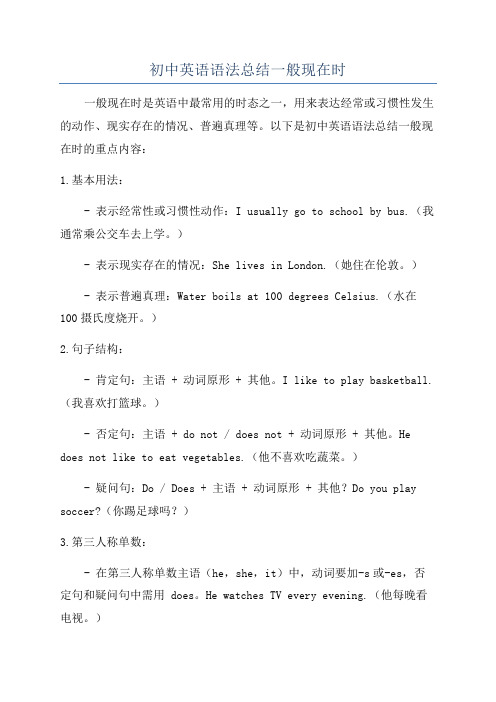
初中英语语法总结一般现在时一般现在时是英语中最常用的时态之一,用来表达经常或习惯性发生的动作、现实存在的情况、普遍真理等。
以下是初中英语语法总结一般现在时的重点内容:1.基本用法:- 表示经常性或习惯性动作:I usually go to school by bus.(我通常乘公交车去上学。
)- 表示现实存在的情况:She lives in London.(她住在伦敦。
)- 表示普遍真理:Water boils at 100 degrees Celsius.(水在100摄氏度烧开。
)2.句子结构:- 肯定句:主语 + 动词原形 + 其他。
I like to play basketball.(我喜欢打篮球。
)- 否定句:主语 + do not / does not + 动词原形 + 其他。
He does not like to eat vegetables.(他不喜欢吃蔬菜。
)- 疑问句:Do / Does + 主语 + 动词原形 + 其他?Do you play soccer?(你踢足球吗?)3.第三人称单数:- 在第三人称单数主语(he,she,it)中,动词要加-s或-es,否定句和疑问句中需用 does。
He watches TV every evening.(他每晚看电视。
)- 一些以s, sh, ch, x, o结尾的单词,需要在动词后加-es,如:misses,washes,watches。
4.频率副词:- 频率副词通常放在动词之前,用于修饰动词。
例如:She always helps others.(她总是帮助别人。
)5.现在进行时与一般现在时的区别:- 现在进行时表示现在正在发生的动作,一般与现在时间状语连用,或表示现阶段的临时情况。
例如:I am studying for the exam.(我正在准备考试。
- 一般现在时表示经常性、习惯性的动作或客观存在的状态。
例如:I usually play soccer on weekends.(我通常在周末踢足球。
初中英语知识点总结一般现在时
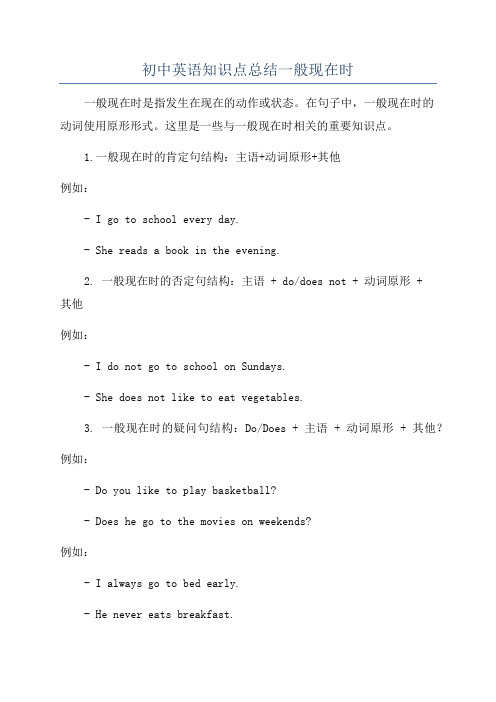
初中英语知识点总结一般现在时一般现在时是指发生在现在的动作或状态。
在句子中,一般现在时的动词使用原形形式。
这里是一些与一般现在时相关的重要知识点。
1.一般现在时的肯定句结构:主语+动词原形+其他例如:- I go to school every day.- She reads a book in the evening.2. 一般现在时的否定句结构:主语 + do/does not + 动词原形 +其他例如:- I do not go to school on Sundays.- She does not like to eat vegetables.3. 一般现在时的疑问句结构:Do/Does + 主语 + 动词原形 + 其他?例如:- Do you like to play basketball?- Does he go to the movies on weekends?例如:- I always go to bed early.- He never eats breakfast.5. 表示客观真理、规律或常识时,一般现在时可用于所有人称,不需要使用助动词do/does。
例如:- The sun rises in the east.- Water boils at 100 degrees Celsius.6. 当主语为第三人称单数时,动词需要变化。
一般情况下,加上-s 或-es。
例如:- She eats lunch at 12 o'clock.- The dog barks loudly.7.部分动词在第三人称单数时需要做变化- go→goes- do→does- have→has例如:- He goes to school by bus.- She does her homework every day.- My mother has a pet cat.8. 当主语为we, they, you或复数名词时,动词不需要做变化。
初中英语语法六大时态

初中英语语法六大时态初中英语通常涵盖的六大时态是:一般现在时、一般过去时、一般将来时、现在进行时、过去进行时和现在完成时。
以下是这些时态的基本结构和用法:1.一般现在时 (Present Simple)1.结构:主语+ 动词原形(第三人称单数使用动词第三人称单数形式)2.用途:描述经常发生的动作或状态;表达客观事实、普遍真理或习惯性动作;表示主语的特征或状态。
3.例子:She always gets up early. (她总是早起。
)2.一般过去时 (Past Simple)1.结构:主语+ 动词过去式2.用途:描述过去某个时间发生的动作或状态;叙述过去的事实或经历。
3.例子:I watched TV last night. (我昨晚看了电视。
)3.一般将来时 (Future Simple)1.结构:主语+ will + 动词原形2.用途:表示将来某个时间要发生的动作或状态;表示计划、意愿或预测。
3.例子:She will go to the party tomorrow. (她明天要去参加聚会。
)4.现在进行时 (Present Continuous)1.结构:主语+ be 动词(am/is/are)+ 动词-ing2.用途:描述当前正在进行的动作或正在发生的情况。
3.例子:They are playing football now. (他们现在正在踢足球。
)5.过去进行时 (Past Continuous)1.结构:主语+ be 动词的过去式(was/were)+ 动词-ing2.用途:描述过去某个时间正在进行的动作或状态。
3.例子:When I was a child, I was always playing outside. (当我还是个孩子的时候,我总是在外面玩。
)6.现在完成时 (Present Perfect)1.结构:主语+ have/has + 过去分词2.用途:描述过去发生的动作对现在造成的影响或结果;表示从过去某个时间开始一直持续到现在的动作或状态。
初中英语语法:一般现在时、一般过去时和一般将来时
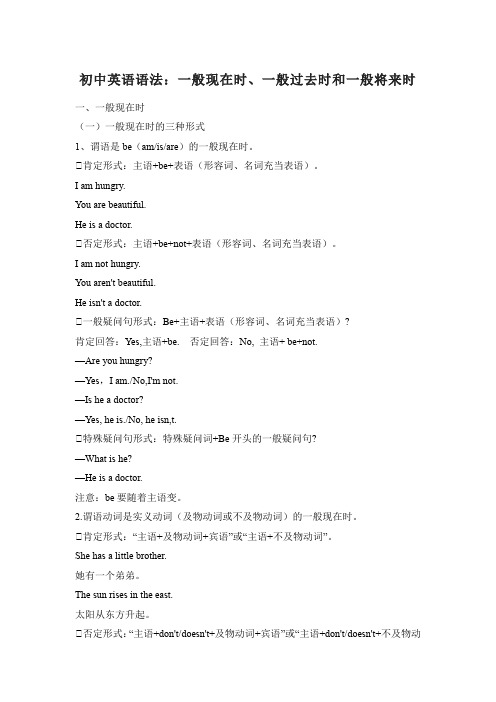
初中英语语法:一般现在时、一般过去时和一般将来时一、一般现在时(一)一般现在时的三种形式1、谓语是be(am/is/are)的一般现在时。
①肯定形式:主语+be+表语(形容词、名词充当表语)。
I am hungry.You are beautiful.He is a doctor.①否定形式:主语+be+not+表语(形容词、名词充当表语)。
I am not hungry.You aren't beautiful.He isn't a doctor.①一般疑问句形式:Be+主语+表语(形容词、名词充当表语)?肯定回答:Yes,主语+be. 否定回答:No, 主语+ be+not.—Are you hungry?—Yes,I am./No,I'm not.—Is he a doctor?—Yes, he is./No, he isn,t.①特殊疑问句形式:特殊疑问词+Be开头的一般疑问句?—What is he?—He is a doctor.注意:be要随着主语变。
2.谓语动词是实义动词(及物动词或不及物动词)的一般现在时。
①肯定形式:“主语+及物动词+宾语”或“主语+不及物动词”。
She has a little brother.她有一个弟弟。
The sun rises in the east.太阳从东方升起。
①否定形式:“主语+don't/doesn't+及物动词+宾语”或“主语+don't/doesn't+不及物动词”。
She doesn't have a little brother.她没有弟弟。
I don't eat every morning.我每天早晨都不吃饭。
①一般疑问句形式:“Do/Does+主语+及物动词原形+宾语”或“Do/Does+主语+不及物动词原形”。
肯定回答:Yes,主语+do/does. 否定回答是:No, 主语+ don't/doesn't.—Do you eat every morning?—Yes, I do./No, I don't.—Does she have a little brother?—Yes, she does./No, she doesn't.①特殊疑问句:特殊疑问词+do/does开头的一般疑问句?What do you like?When do you go to school?注意:根据主语确定用do还是does。
中考英语《一般现在时》知识点:一般现在时态
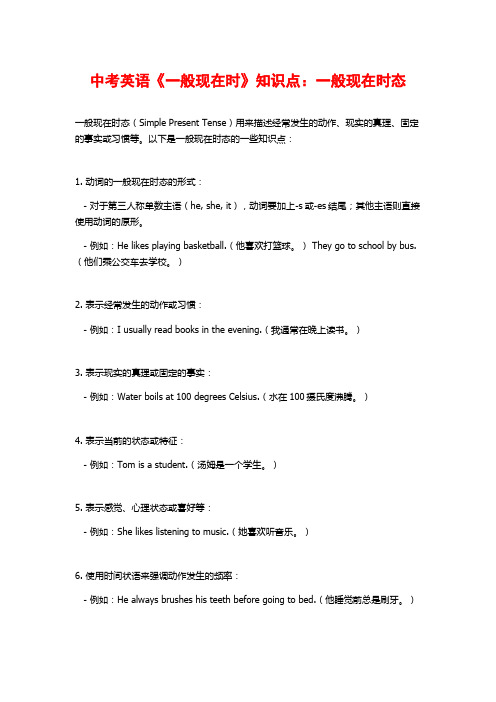
中考英语《一般现在时》知识点:一般现在时态一般现在时态(Simple Present Tense)用来描述经常发生的动作、现实的真理、固定的事实或习惯等。
以下是一般现在时态的一些知识点:1. 动词的一般现在时态的形式:- 对于第三人称单数主语(he, she, it),动词要加上-s或-es结尾;其他主语则直接使用动词的原形。
- 例如:He likes playing basketball.(他喜欢打篮球。
) They go to school by bus.(他们乘公交车去学校。
)2. 表示经常发生的动作或习惯:- 例如:I usually read books in the evening.(我通常在晚上读书。
)3. 表示现实的真理或固定的事实:- 例如:Water boils at 100 degrees Celsius.(水在100摄氏度沸腾。
)4. 表示当前的状态或特征:- 例如:Tom is a student.(汤姆是一个学生。
)5. 表示感觉、心理状态或喜好等:- 例如:She likes listening to music.(她喜欢听音乐。
)6. 使用时间状语来强调动作发生的频率:- 例如:He always brushes his teeth before going to bed.(他睡觉前总是刷牙。
)需要注意的是,一般现在时态还可以用来表示将来安排好的事情,但需要配合适当的时间状语来使用。
例如:We have a meeting tomorrow.(我们明天有一个会议。
)但在这种情况下,一般现在时态通常会与表示将来的时间短语一起使用,比如tomorrow(明天)、next week(下周)等。
一般现在时知识点七年级

一般现在时知识点七年级一般现在时是初学英语的必修知识点之一,它用于描述现在的状态、真实情况以及规律性的动作等情况。
在这篇文章中,我们将介绍一般现在时的构成、用法以及常见的错误用法。
希望能够帮助大家更好地掌握这个知识点。
一、一般现在时的构成一般现在时的构成非常简单,只需要在动词原形后加上第三人称单数的“s”或“es”即可。
例如:He loves playing soccer.She watches TV every night.注意,当动词以辅音字母+y结尾时,要将y改为i再加上“es”,例如:She studies English very hard.二、一般现在时的用法1. 描述现在的状态一般现在时用于描述现在的状态,比如:I live in New York.He works in a bank.注意,一般现在时不能用于描述临时或短暂的情况。
比如,正确的说法应该是“I am staying at the hotel”,而不是“I stay at the hotel”(因为住酒店是临时性的)。
2. 描述真实情况一般现在时还用于描述真实情况,比如:The sun rises in the east.Water boils at 100 degrees Celsius.3. 描述规律性的动作一般现在时也用于描述规律性的动作,比如:She brushes her teeth twice a day.They have breakfast at 7 o'clock every morning. 4. 对事实和真理的提出一般现在时还用于对事实和真理的提出,比如:Birds can fly.The earth revolves around the sun.注意,这种用法通常用于科学和历史领域。
三、常见的错误用法1. 在第三人称单数上加动词不定式“to”错误:She likes to to dance.正确:She likes to dance.2. 在第一人称和第二人称上加“s”错误:I works very hard.正确:I work very hard.错误:You likes Chinese food.正确:You like Chinese food.3. 在不定式上加“s”错误:She wants to knows the answer.正确:She wants to know the answer.四、总结一般现在时是英语中最基本的时态之一,在日常生活和学习中被广泛使用。
一般现在时的语法公式
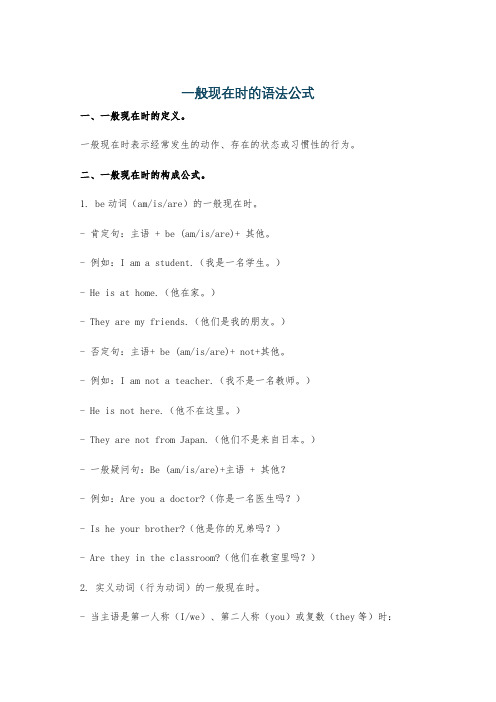
一般现在时的语法公式一、一般现在时的定义。
一般现在时表示经常发生的动作、存在的状态或习惯性的行为。
二、一般现在时的构成公式。
1. be动词(am/is/are)的一般现在时。
- 肯定句:主语 + be (am/is/are)+ 其他。
- 例如:I am a student.(我是一名学生。
)- He is at home.(他在家。
)- They are my friends.(他们是我的朋友。
)- 否定句:主语+ be (am/is/are)+ not+其他。
- 例如:I am not a teacher.(我不是一名教师。
)- He is not here.(他不在这里。
)- They are not from Japan.(他们不是来自日本。
)- 一般疑问句:Be (am/is/are)+主语 + 其他?- 例如:Are you a doctor?(你是一名医生吗?)- Is he your brother?(他是你的兄弟吗?)- Are they in the classroom?(他们在教室里吗?)2. 实义动词(行为动词)的一般现在时。
- 当主语是第一人称(I/we)、第二人称(you)或复数(they等)时:- 肯定句:主语+动词原形+其他。
- 例如:I like reading books.(我喜欢读书。
)- We play football on Sundays.(我们在星期天踢足球。
)- You go to school by bike.(你骑自行车去上学。
)- They have a lot of fun.(他们玩得很开心。
)- 否定句:主语+ don't+动词原形+其他。
- 例如:I don't like math.(我不喜欢数学。
)- We don't watch TV every day.(我们不是每天都看电视。
)- You don't know him.(你不认识他。
七年级英语重点语法:一般现在时

七年级英语重点语法:一般现在时1.一般现在时的用法①表示经常性、习惯性的动作或存在的状态。
常与频度副词连用。
I often take a walk in the park. 我经常在公园散步。
These T-shirts are new. 这些T恤衫是新的。
①表示客观事实、真理。
The sun rises in the east and sets in the west. 太阳东升西落。
①在时间、条件状语从句中表示将来的动作。
If it doesn’t rain tomorrow, I will go bike riding in the open air. 如果明天不下雨,我将在户外骑自行车。
I’ll tell her the good news when she comes back. 当她回来的时候,我将把这个好消息告诉她。
①表示按计划或安排将要发生的动作,可用一般现在时表将来。
但只限于start,begin,leave,go,come,arrive,return,take place等。
2.一般现在时的构成语法知识精练题型一:“三单”形式的变化规则1.—What happens when water freezes?—It ________ into ice.A.turns B.will turn C.turned D.has turned2.Tom ________ to school by bike every morning.A.go B.went C.is going D.goes3.The boy never ________ his teeth before bedtime. His parents are very angry.A.brush B.brushes C.brushed D.brushing4.The earth is a planet (行星) and it ________ around the sun.A.goes B.go C.will go D.went5.Mr. Green has two dogs. He ____________ them every morning.A.walked B.will walk C.walks D.is walking6.Amy usually ________ sports on Sunday mornings.A.is having B.has C.has had D.was having7.Tony usually ________ to school on time, but this morning he ________ late.A.gets; arrives B.got; arrived C.gets; arrived D.got; arrives8.She usually ________ to music in the evening, but now she ________ TV.A.listens; watches B.is listening; watchesC.listens; is watching D.is listening; is watching9.Mike usually _______ up at six thirty in the morning, but he _______ up at seven this morning. He was late for school.A.got; got B.got; gets C.gets; gets D.gets; got10.Linda _________ a twin brother, and she is _________ than him.A.is; taller B.has; tall C.has; taller D.have; taller11.It often _________ here in winter. Look! It’s _________ again.A.snows; snowing B.snowy; snowingC.snows; snows D.snowing; snows12._______ his sister, he also ________ running.A.Like; like B.Likes; likes C.Like; likes D.Likes; like13.Tommy always ________ to keep healthy. Look! He ________ in the pool now.A.swims; swims B.swims; is swimmingC.is swimming; is swimming D.is swimming; swims14.Bob ________ basketball and he looks ________ his father.A.likes, like B.like, likes C.likes, likes D.like, like15.—Does Ella like ________?—Yes. She often ________ things from the stores.A.shop; buys B.shop; is buyingC.shopping; buys D.shopping; is buying16.It often _________ heavily in summer. We have to wear raincoats when we go out.A.rains B.rain C.snows D.snow17.It often ______ in South China.A.snow B.snows C.rainy D.rains18.Jane sometimes ________ around the city with her parents on weekends.A.travel B.travelsC.traveled D.will travel19.When ice melts, it ________ into water.A.turns B.will turn C.turned D.is turning20.Mike ________ of medium height and he ________ short hair.A.is, is B.are, have C.has, has D.is, has题型二:表示经常性动作/状态21.I ______ basketball on the playground with my friends every Saturday.A.play B.will play C.played D.am playing22.Every year, the Vienna New Year’s Concert ________ place on 1st January.A.takes B.is taking C.took D.will take23.Tom usually ______ his bike to school but he ______ the subway there this morning.A.rides; took B.rides; takes C.ride; took D.rode; took24.Chinese people often ________ when they meet visitors.A.smile B.smiled C.are smiling D.will smile25.—Steve, what do you often do after school?—I often ________ basketball with my friends.A.play B.played C.will play D.am playing26.Susan lives far from school. She usually ________ a bus to school.A.has taken B.took C.takes D.will take27.—Listen! Someone ________ in the next room.—It must be Lily. She ________ singing every afternoon.A.sings; practices B.sings; practicing C.is singing; practices D.is singing; is practicing 28.—It ________ heavily last night. So there is snow on the ground everywhere today.—Yes. It often ________ here in winter.A.snowed; snows B.snowed; is snowing C.snows; is snowing D.snows; snows 29.Jim often ________ for a walk after dinner. But yesterday he ________.A.go; doesn’t B.goes; didn’t C.went; didn’t D.went; doesn’t 30.He often _________ French after _________ his homework every day.A.study; finish B.studied; finished C.studies; finishing D.studying; finishing题型三:表示现在的能力/特征31.—Does Alice like oranges?—No, she doesn’t. She ________ apples.A.like B.liking C.liked D.likes32.The store _______ T-shirts in all colors and they’re on _______.A.sell; sale B.sale; sell C.sells; sale D.sales; sell33.My brother _______ the piano very well, but he doesn’t have time to play now.A.will play B.is playing C.played D.plays34.Many years ago, I ________ to be a doctor. But now ________ a worker.A.wanted; I was B.wanted; I’mC.want; I’m D.want; I was35.My sister ________ walk a year ago, but now she ________.A.couldn’t; could B.couldn’t; can C.can; can D.could; could题型四:表示事实或客观真理36.—Where ________ he from?—He is from the United States.A.was B.are C.am D.is37.Allen used _________ to school, but now he _________ to school by bus.A.walking; goes B.walking; is going C.to walk; goes D.to walk; going 38.One of my friends ________ a pet dog. The dog’s name is Duoduo.A.have B.has C.to have D.having39.— We ________ very simply and do not spend much money on food.— That’s why you’re called the Greens.A.eat B.ate C.will eat D.had eaten40.— Look at the sign there! It ________ “No fishing!”— Sorry, I __________ notice it.A.said; don’t B.said; didn’t C.says; didn’t D.says; don’t 41.—Let’s buy some ________ for our school trip.—That ________ good.A.strawberry; sound B.salad; sounds C.hamburger; sounds D.pear; sound42.I ________ a red book. She ________ two red books.A.have; has B.has; have C.have; have D.has; has43.As we all know, light ________ a lot faster than sound.A.travels B.travelled C.is travelling D.to travel44.One of his best friends ________ the US.A.come from B.is from C.are from D.are coming from 45.His mother ________ in a hospital, but she ________ there these days.A.works; isn’t workingB.is working; worksC.is work; doesn’t workD.works; not works题型五:表示现在发生的具体动作46.—What club does he join?—He can _________ pictures, so he ________ the art club.A.draw; join B.draws; joins C.draws; join D.draw; joins 47.—Great news! The land (着陆) of The Shenzhou XIII is a great success!—It ________ me excited and ________ proud to be a Chinese.A.make; feel B.made; to feel C.makes; feel D.makes; feeling 48.I at the picture now. I some koalas in it.A.am looking; see B.look; seeingC.am looking; am seeing D.look; see49.—The phone is ringing, Sam.— I _______, but I’m busy. Could you answer it, please?A.know B.knowing C.am knowing D.knew 50.Mike _________ the earphones on the sofa a moment ago, but now they _________ there. A.put; weren’t B.put; aren’tC.putted; are D.puts; are参考答案:1.A【详解】句意:——当水冻结时会发生什么?——它会变成冰。
初中英语语法一般现在时全解
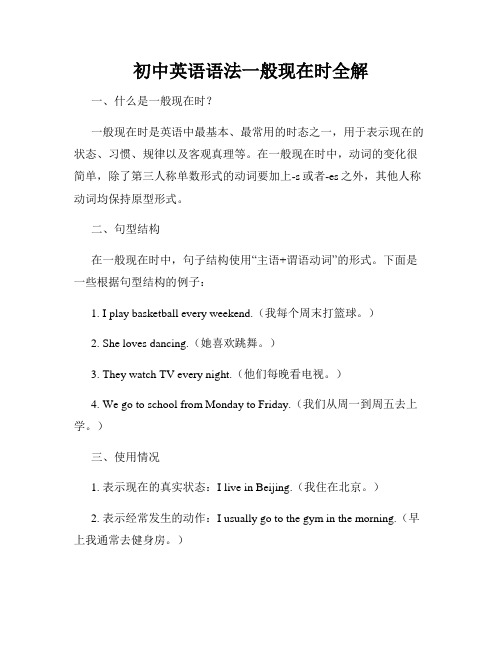
初中英语语法一般现在时全解一、什么是一般现在时?一般现在时是英语中最基本、最常用的时态之一,用于表示现在的状态、习惯、规律以及客观真理等。
在一般现在时中,动词的变化很简单,除了第三人称单数形式的动词要加上-s或者-es之外,其他人称动词均保持原型形式。
二、句型结构在一般现在时中,句子结构使用“主语+谓语动词”的形式。
下面是一些根据句型结构的例子:1. I play basketball every weekend.(我每个周末打篮球。
)2. She loves dancing.(她喜欢跳舞。
)3. They watch TV every night.(他们每晚看电视。
)4. We go to school from Monday to Friday.(我们从周一到周五去上学。
)三、使用情况1. 表示现在的真实状态:I live in Beijing.(我住在北京。
)2. 表示经常发生的动作:I usually go to the gym in the morning.(早上我通常去健身房。
)3. 表示普遍真理或客观规律:The sun rises in the east.(太阳从东方升起。
)4. 表示评论、陈述、想法等:I think English is an interesting subject.(我认为英语是个有趣的科目。
)四、一般现在时的注意事项1. 第三人称单数形式的动词要加上-s或者-es:He reads books every day.(他每天阅读书籍。
)但是要注意规则动词的变化,如do变为does。
2. 否定句需要在谓语动词前加上助动词do或does,并在其后加上not:I do not like coffee.(我不喜欢咖啡。
)She does not listen to music.(她不听音乐。
)3. 疑问句需要将助动词do或does提前至主语之前:Do you play tennis?(你打网球吗?)Does she go to school by bus?(她坐公交车去上学吗?)4. 当主语为第三人称单数时,疑问句直接用助动词does,无需加s:Does he like ice cream?(他喜欢冰淇淋吗?)五、总结一般现在时是英语中最基础、最常用的时态之一,用于表示现在的状态、习惯、规律以及客观真理等。
- 1、下载文档前请自行甄别文档内容的完整性,平台不提供额外的编辑、内容补充、找答案等附加服务。
- 2、"仅部分预览"的文档,不可在线预览部分如存在完整性等问题,可反馈申请退款(可完整预览的文档不适用该条件!)。
- 3、如文档侵犯您的权益,请联系客服反馈,我们会尽快为您处理(人工客服工作时间:9:00-18:30)。
一般现在时讲解和练习一、定义:一般现在时表示经常或习惯性的动作,也可表示现在的状态或主语具备的性格和能力。
例:( 1) .表示事物或人物的特征、状态。
The sky is blue. 天空是蓝色的。
2) .表示经常性或习惯性的动作。
I get up at six every day. 我每天六点起床。
3) .表示客观现实。
The earth goes around the sun.地球绕着太阳转。
二、一般现在时常用时间状语、时间副词in the morning/afternoon/eveningevery week (day, year, month⋯)on Sundays (Monday, Tuesday⋯)at night, once a week,.always 总是 , usually 通常 , often 经常 , sometimes 有时 , never 从不三、用法:1.肯定句:ἀp ̀]娀z 紀v 1)句中有 be(am,is, are)和情态动词时,be 动词时,主语是 I 时要用 am,主语是 you 时要用 are,其他用 is。
② 是情态动词时,后面的动词用原型③例: I am a student.You are very beautiful.She is my best friend.He can do his homework by himself.(2)没有be(am,is, are)动词和情态动词:主语为第三人称单数( she ,he ,it )、单数可数名词、不可数名词的,动词要按规则加上 s 或 es;主语是复数可数名词的肯定句,动词用原形。
例:① She( He, It ) likes fish.她(他,它)喜欢鱼。
(主语为第三人称单数)② The table has four legs.桌子有四条腿。
(主语为单数可数名词 )③ Water boils at 100 degrees Celsius.水在 100 度沸腾。
(主语为不可数名词)They go to school every day . 他们每天都去上学。
(主语是复数可数名词的,动词用原形)注意的问题:第三人称单数以及第三人称单数时动词的变化规则在一般现在时中,当主语是第三人称单数时,谓语动词要用第三人称单数形式,即常在动词原形后加 -s 或 -es。
但有些同学们对于哪些主语是第三人称单数还不十分清楚,现归纳总结如下:1、人称代词he, she, it 是第三人称单数。
如:He likes watching TV.他喜欢看电视。
She has lunch at twelve. 她十二点吃午餐。
It looks like a cat.它看起来像只猫。
2、单个人名、地名或称呼作主语;是第三人称单数。
如:①Han Mei looks like her mother. 韩梅看起来像她的母亲。
② Beijing is in China. 北京在中国。
③ Uncle Wang often makes cakes. 王叔叔经常做蛋糕。
3、单数可数名词或"this / that / the+ 单数可数名词"作主语时,是第三人称单数。
如:A horse is a useful animal. 马是有用的动物。
② This book is yours. 这本书是你的。
①That car is red. 那辆小汽车是红色的。
④ The cat is Lucy's. 这只猫是露茜的。
4、不定代词 someone, somebody, nobody, everything, something 等及指示代词 this, that 作主语时,是第三人称单数。
如:(Everyone is here. 大家到齐了。
②There is something wrong with the watch. 这块手表有毛病。
③ This is a pen. 这是一支钢笔。
④ That is an eraser. 那是一块橡皮擦。
5、不可数名词作主语时为第三人称单数。
如:The milk is in the glass. 牛奶在玻璃杯里。
② The bread is very small. 那面包很小。
6、当数字或字母作主语时,看作第三人称单数。
如:"6" is a lucky number. "6" 是个吉利数字。
② "I" is a letter. "I" 是个字母。
动词 +s 的变化规则1.一般情况下,直接加-s,如: cook-cooks, make-makesruns gets likes collets takes plays climbs 2.以 s. x. sh. ch.o 结尾,加 -es,如:guess-guesses, wash-washes, watch-watches, go-goes 3.以―辅音字母 +y ‖结尾,变y 为 i, 再加 -es,如: study-studies方法与发音:1.一般情况下,直接加-seg. works, plays, rains, sees2.以 sh, ch, s, x 或 o 结尾的词后加–eseg. washes, teaches, fixes, does, goes3.以辅音字母加 -y 结尾的,先把 ?y‘改成 ?i ‘再,加 -eseg. studies, flies, carries注意 : 动词加-s 以后的读音 .动词加 -s 后的读音1.在 [p] [t] [k] [f]等清辅音后,发清辅音/s/eg. helps, works, likes, hates ,laughs2.在浊辅音和元音后,发浊辅音/z/eg. drives, cleans, plays3.在 [s] [z] [t?]∫[d]?][后,发/iz/rises, wishes, teaches, urges4.在 [t] [d] 后,发/ts//dz/eg. fits, sets, needs其他情况下发 [z]eg. plans, cries, shows练习 11. Jenny _____ in an office. Her parents _____in a hospital.A work; worksB works; workC work; are workingD is working;work 2. One of the boys_______ a black hat. A have B there is Cthere are D has3. Wang Mei ______ music and often ______ to music.A like; listenB likes; listensC like; are listeningD liking ; listen①Jenny______ English every evening.A has studyB studiesC studyD studied①The teachers ________(speak) English in class.①The teacher ________(speak) English in class.2.否定句:(1) 句中有 be 动词 (am , is , are )或情态动词 (may , can , must , should) 时,否定句在 be 动词和情态动词后加not,I am not a teacher. He can not fly .(2) 句中没有 be 动词 (am , is , are )或情态动词 (may , can , must , should) 时,主语为第三人称单数的否定句,在动词原形前加 does + not (doesn ‘。
t)He doesn ‘ t like cats.(3) 句中没有be 动词 (am , is , are ) 或情态动词 (may , can , must , should) 时,主语为复数可数名词的否定句,在动词原形前加do + not (don ‘。
t)They don ‘ t go to school on Sundays.练习 21. The cat _________(not like) you.2.Brian(not live) in China.3.The picture ______ nice.A. don ‘ t lookB. is lookedC. doesn‘ t lookD. is lookingI have many books.( 改为否定句) _________________________5.厦门不下雪。
__________________________________________6.她不看新闻。
__________________________________________7.我妈妈不喜欢吃肉 ______________________________________3.疑问句:(1)句中有 be 动词 (am , is , are )或情态动词 (may , can , must , should) 时,一般疑问句将 be 动词或情态动词放在句首。
由肯定句变为一般疑问句的步骤:. 把 be 动词( am , is , are )或情态动词 (may , can , must , should) 提前。
② .大写和小写的转换,句首的第一个字母要大写。
③ .句末要加问号。
例:肯定句: She is a student . 疑问句: Is she a student ?肯定句 : He can swim.疑问句:Can he swim? .疑问句的回答:用什么问就用什么来回答。
Is she a student ? Yes, she is . No, she isn‘ t.Can you swim?Yes, I can .Yes, I can‘ t.(2) 句中如果没有be 动词 (am , is , are )或情态动词 (may , can , must , should) 时,主语为第三人称单数( she ,he ,it )、单数可数名词、不可数名词的疑问句要用 does 来提问。
即在句首加does,句子中原有动词用原形例:— Does he like Chinese? 他喜欢汉语吗?—Yes, he does.是的,他喜欢(汉语 )。
